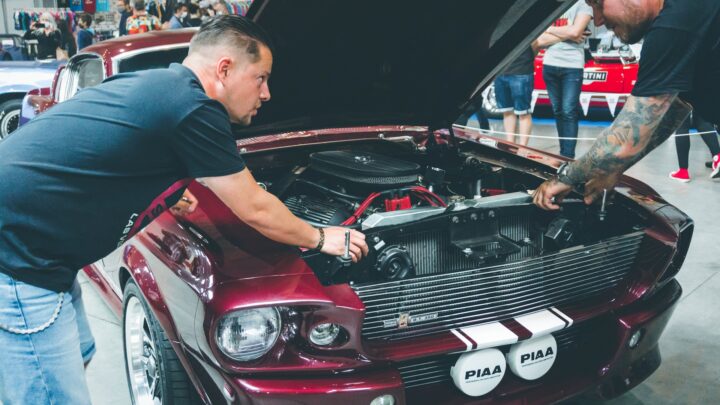Preventive Maintenance: Regular Checks and Replacement of Your Powerstroke Coolant Hose
When it comes to taking care of your vehicle, sometimes it’s the small things that make the biggest difference. This is especially true for those who own vehicles with Powerstroke engines, where regular maintenance isn’t just a recommendation; it’s a necessity for ensuring vehicle longevity and safety.
The Powerstroke engine, a powerhouse in Ford’s diesel lineup, demands particular attention to its cooling system to maintain its renowned performance and durability. Central to this system is the coolant hose, a component that, despite its simplicity, plays an important role in engine health.

This article emphasizes the critical need for regular checks and timely replacement of coolant hoses in Powerstroke engines, not just as a maintenance routine, it’s about ensuring your vehicle stays reliable, safe, and ready to perform at its best.
Understanding the Powerstroke Engine Cooling System
Ford’s engineering capacity is demonstrated by the Powerstroke engine, which is especially impressive in terms of power and efficiency. At the heart of this engine’s reliability is its cooling system, designed to manage the immense heat generated during operation. The coolant hose is more than just a conduit for antifreeze; it’s the lifeline that maintains the engine’s temperature balance, preventing overheating and ensuring smooth performance.
Nevertheless, Powerstroke engines’ durability conceals a weakness in their cooling mechanisms. If not properly maintained, the coolant hose—which is frequently disregarded—can become your worst enemy.
Common Issues with Powerstroke Coolant Hoses
Powerstroke engines, particularly those in heavy-duty trucks, face demanding conditions that can accelerate wear and tear on coolant hoses. These hoses, exposed to constant high temperatures and pressure fluctuations, are prone to degradation. Common issues include cracking, softening, and leakage, often exacerbated by the harsh environments these trucks frequently operate in. These problems, if left unchecked, can lead to coolant loss, engine overheating, and in severe cases, engine failure.
Signs of Coolant Hose Deterioration
When it comes to coolant hose maintenance on a Powerstroke, attention to detail is crucial. Visible signs of deterioration include cracks, swelling, or visible leaks on or around the hose. Additionally, symptoms such as an unexplained drop in coolant levels, overheating, or steam emanating from the engine bay can indicate a failing hose.
The implications of ignoring these signs are severe, potentially leading to engine damage or breakdowns. Regularly monitoring these indicators can preempt catastrophic failures and ensure the longevity of your Powerstroke engine.
Importance of Regular Coolant Hose Inspections
To safeguard the health of your Powerstroke engine, routine coolant hose inspections are needed. These inspections should be part of your regular maintenance schedule, at least bi-annually or by the vehicle’s service manual.
While some checks can be done independently, like visual inspections for cracks or leaks, professional help may be necessary for a more thorough examination. This regular inspection routine is crucial for early detection of potential issues, ensuring prompt intervention before minor wear escalates into major problems.
Early Detection of Potential Issues
Catching problems early can be the difference between a simple hose replacement and a costly engine overhaul. Regular inspections allow for the identification of early signs of wear, such as minor cracks or soft spots on the hose. Addressing these issues promptly not only saves money but also ensures continuous and reliable engine performance.
Selecting High-Quality Replacement Hoses
When it comes time for replacement, choosing the right coolant hoses for Powerstroke engines is crucial. Material quality and compatibility with your specific engine model are paramount. Silicone hoses are often recommended for their resilience against high temperatures and their flexibility, which minimizes the risk of cracking under stress.
They also tend to have a longer lifespan than traditional rubber hoses. When selecting a replacement hose, consider reputable brands known for their quality and durability, ensuring a perfect match for your Powerstroke’s demanding requirements.
Hose Replacement Process
Replacing a coolant hose in a Powerstroke engine involves several steps, each critical for a successful and safe replacement:
- Preparation: Ensure the engine is cool and gather the necessary tools, including a new coolant hose, clamps, coolant, and basic hand tools.
- Removal: Carefully remove the clamps and detach the old hose from the radiator and engine block. Drain any remaining coolant into a container.
- Installation: Attach the new hose, securing it with the clamps at both ends. Ensure it fits snugly without any twists or kinks.
- Coolant Refill: Refill the cooling system with the appropriate type and amount of coolant. Bleed the system to remove any air pockets.
- Inspection: Check for leaks and ensure all connections are tight. Start the engine and monitor the temperature gauge for signs of overheating.
Proactive Measures for Hose Maintenance
Proactive maintenance extends beyond regular inspections and timely replacements. Ensuring proper coolant usage and maintaining correct coolant levels are vital for hose health. Regularly check the coolant concentration and top it off if necessary. It’s also important to use the recommended type of coolant for your Powerstroke engine, as using the wrong type can lead to corrosion and hose damage.
Additionally, general engine maintenance, like regular oil changes and filter replacements, contributes to a healthy cooling system, as it ensures the engine operates within optimal parameters, reducing stress on the coolant hose.
Conclusion
In conclusion, the coolant hose may seem like a small part of your Powerstroke engine, but its role is significant in ensuring the engine’s health and efficiency. Regular checks, timely replacements, and choosing the right hoses are not just maintenance tasks; they’re investments in your vehicle’s longevity. Embrace preventive maintenance as a cornerstone of your vehicle care routine. By doing so, you’re not just maintaining an engine; you’re preserving a powerhouse.


